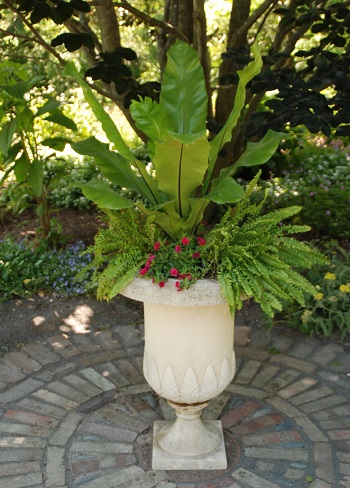
Last year’s record-high temperatures across much of the country took a toll on gardens and landscapes. Once again, above-normal summer temperatures are in the forecast for many regions of the country. Adjusting how you manage your gardens and landscape can help plants thrive as temperatures rise.
Water plants thoroughly to promote deep drought-tolerant roots that help boost the plants’ pest resistance. Wait until the top few inches of soil are crumbly and moist before watering most plants. Newly planted perennials, trees, and shrubs need more attention and water than drought-tolerant plants or established ones with more robust root systems that are better able to absorb more moisture. During extended dry periods, even drought-tolerant and established plants may need supplemental water. Water early in the day to reduce water lost to evaporation. Avoid late evening watering that leaves foliage wet at night, increasing the risk of disease.
Apply water directly to the soil above the plant roots using soaker hoses or drip irrigation whenever possible. Water is applied where needed and the slow, steady flow of water is better able to infiltrate the soil and moisten the roots with less runoff. Check soil moisture daily in container gardens and several times a week for raised beds. Both dry out more quickly than in-ground gardens and need to be watered more often.
Further conserve water by spreading a two- to three-inch layer of shredded leaves, evergreen needles, or shredded bark mulch over the soil in garden beds and around trees and shrubs. Mulching conserves moisture keeps roots cooler and moist and suppresses weeds. As the organic mulch decomposes, it adds nutrients and organic matter to the soil. Just pull the mulch away from tree trunks, shrub stems, and the crowns of other plants to avoid rot. Read this article for more information on how to properly mulch plants.
Include plants that are more tolerant of the weather conditions in your area. Those that tolerate both heat and cold extremes will thrive with less care once established.
Incorporate organic matter like compost into the soil. It helps the soil accept and retain water so you will need to water less often. It also adds nutrients to the soil so over time you will need to fertilize less often. This article explains how to build a simple 2 or 3 bin composting system in your backyard.
Use a low-nitrogen, slow-release fertilizer if your garden plants need a nutrient boost. These types of fertilizers release small amounts of nutrients over an extended period. The low level of nitrogen reduces the risk of damaging heat-stressed plants.
Remove weeds from garden beds and borders as soon as they appear. These “plants out of place” steal water and nutrients from your desirable garden plants. Plus, many harbor insects and diseases that are harmful to your garden plants.
Provide stressed plants with a bit of shade from the hot afternoon sun. Container gardens can be moved to a more suitable spot during heat waves. Add a bit of temporary shade to garden plants that are struggling to survive in the blazing hot sun. A strategically placed chair, lattice, or umbrella may be all that is needed. As temperatures drop, you can move plants back in place and remove the temporary shade.
Your garden will greatly benefit from these changes to your summer garden care.
Melinda Myers has written more than 20 gardening books, including Small Space Gardening. She hosts the “How to Grow Anything” DVD series and the Melinda’s Garden Moment TV & radio segments. Her website is MelindaMyers.com.
Photo courtesy of Melinda Myers
Related Articles & Free Email Newsletter Sign Up

6 Tips for Growing Beautiful Dahlias
How to Create a Garden Oasis in Any Size Yard, Deck, or Balcony
How Using Sustainable Water in the Landscape Helps You and the Environment






Comment here